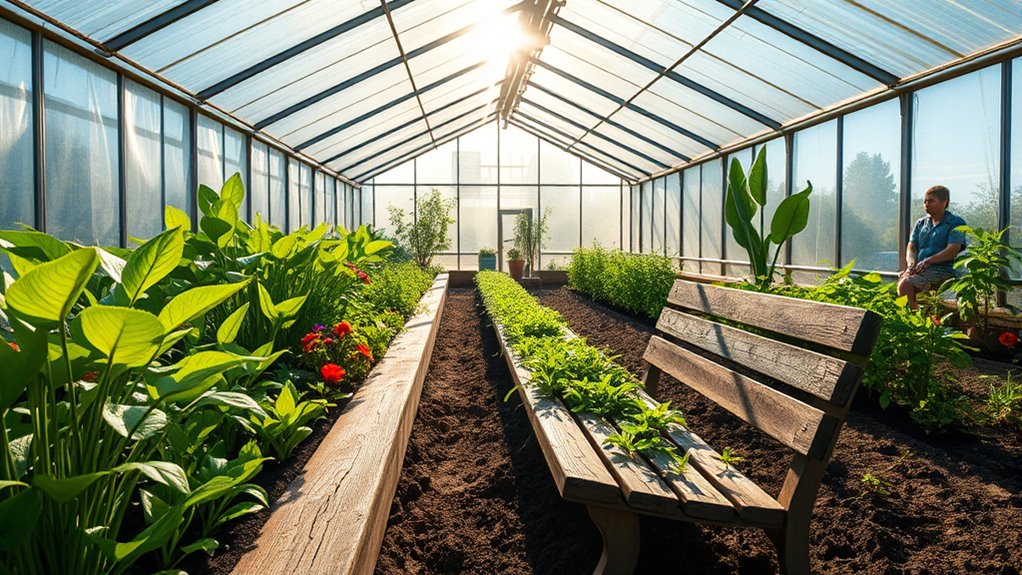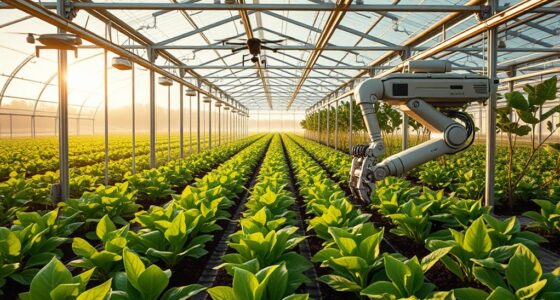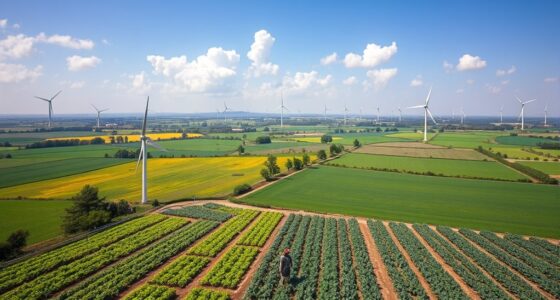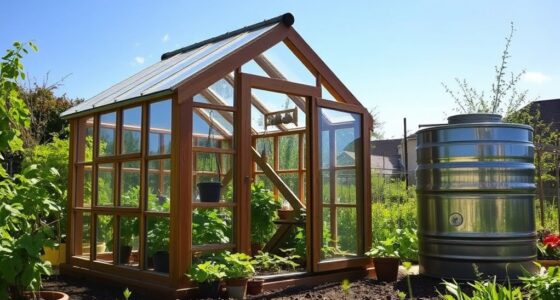Community greenhouses transform urban spaces into hubs of sustainability, education, and health. They provide controlled environments for year-round cultivation, enhance food security, and offer educational programs on sustainable farming. You’ll gain access to fresh produce while engaging in hands-on learning about plant biology and ecology. These spaces foster community connections, improve mental health, and create jobs. Plus, they contribute to a healthier urban environment. You’ll discover even more about their impact and benefits as you explore further.
Key Takeaways
- Community greenhouses support year-round urban gardening, providing controlled environments and enhancing food security through local, fresh produce.
- They promote sustainability by using reclaimed materials and implementing water conservation practices like rainwater harvesting and drip irrigation.
- Educational programs in community greenhouses offer hands-on STEM learning, teaching sustainability and practical gardening skills to residents of all ages.
- Greenhouses foster social connections and enhance mental health, providing a space for community engagement and collaboration among residents.
- They contribute to local economies by creating jobs, increasing property values, and attracting tourism through sustainable agricultural initiatives.
Understanding Community Greenhouses
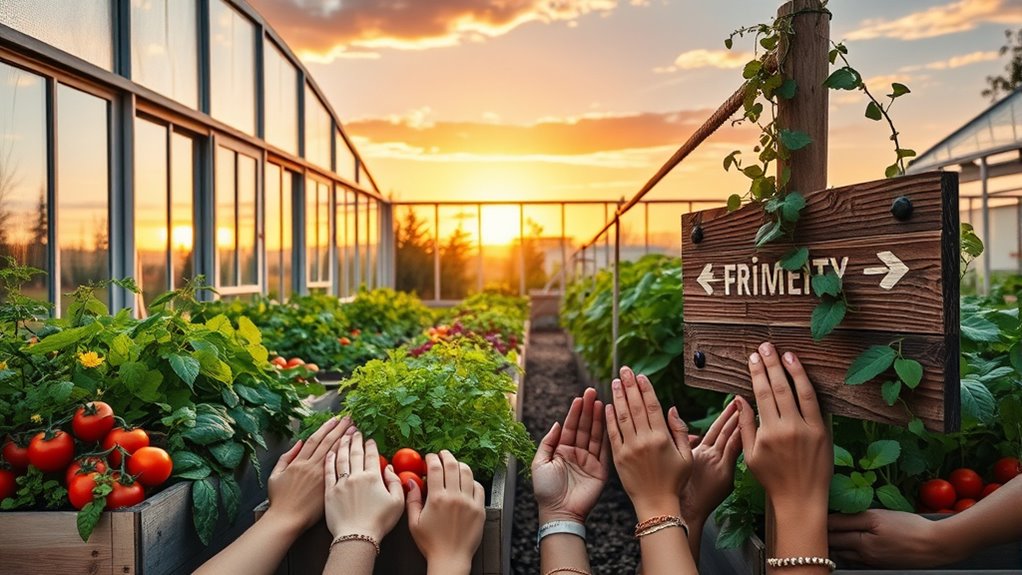
Understanding community greenhouses can transform how you think about urban gardening. These spaces are essential parts of community gardening initiatives, allowing for year-round cultivation and education. Additionally, they often incorporate portable power solutions to maintain optimal growing conditions, ensuring that plants receive adequate light and temperature regulation.
In urban environments, where growing conditions can be tough, these greenhouses provide a controlled environment for nurturing plants. Managed by community volunteers, they often rely on local grants for funding. Community gardens typically serve as shared green spaces for learning sustainable practices, enhancing the educational aspect of greenhouses. Furthermore, they can play a crucial role in protecting seniors from financial scams by providing educational resources on food security and sustainability.
Their primary purpose is to bolster local food production while offering educational opportunities for sustainable practices. Integrating them into existing community gardens enhances their capabilities, making fresh, locally grown produce accessible and improving food security. Moreover, these initiatives can be instrumental in supporting healthy aging by engaging seniors in gardening activities that promote physical and mental well-being.
Additionally, they foster community engagement and social interaction, creating a vibrant hub for learning and collaboration in your neighborhood.
Sustainability Practices in Community Greenhouses
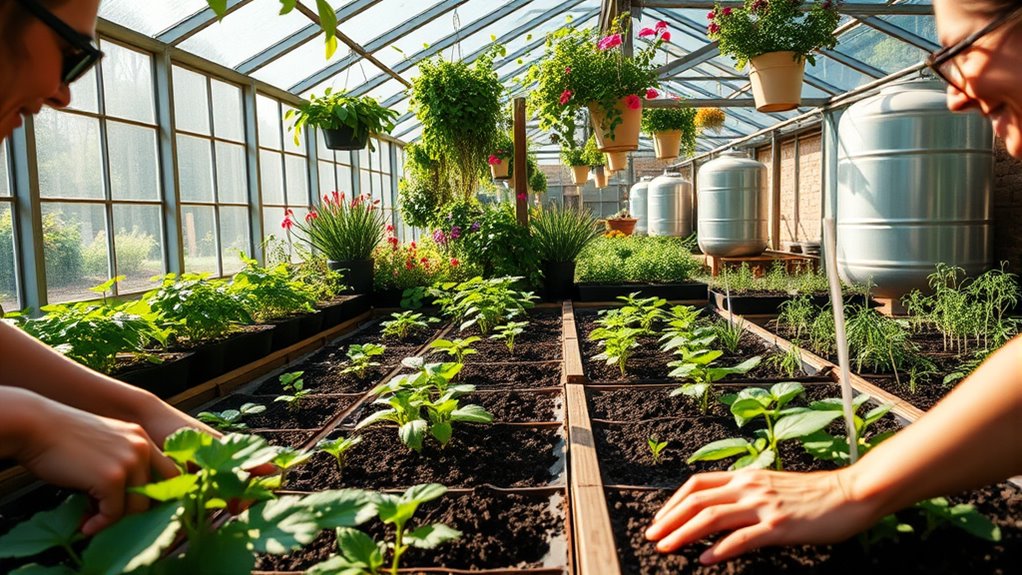
Sustainability practices in community greenhouses not only enhance environmental responsibility but also create a more efficient gardening space. You can use reclaimed wood and recycled plastic panels for construction, ensuring minimal environmental impact. Incorporating rainwater harvesting and drip irrigation systems helps conserve water while maintaining healthy plants. Solar panels can power greenhouse operations, reducing utility costs and greenhouse gas emissions. Additionally, passive solar designs and efficient ventilation maximize energy use, keeping costs low. Moreover, these practices promote environmental awareness and educate community members about sustainable gardening methods, highlighting the importance of eco-friendly practices that can be applied in various settings. Utilizing solar energy solutions can also significantly lower operational costs while contributing to a cleaner environment. By creating comfortable living spaces that accommodate seniors, community greenhouses can support the idea of aging in place while fostering a sense of community.
Educational Opportunities Offered by Community Greenhouses

How can community greenhouses serve as dynamic classrooms? They offer interdisciplinary learning by integrating science, math, and engineering, making education more engaging.
In these greenhouses, you’ll experience hands-on STEM education, exploring concepts like photosynthesis and soil chemistry. You’ll also develop practical skills like teamwork and problem-solving while managing greenhouse operations. Additionally, these programs promote sustainability by teaching students eco-friendly practices and how to minimize waste, fostering cognitive development through interactive learning. Understanding the importance of natural remedies can also be integrated into these lessons, as students learn about sustainable gardening practices. By utilizing backyard greenhouses, students can observe the growth of plants in a controlled environment, enhancing their learning experience.
With projects like hydroponics and seasonal gardening, you’ll immerse yourself in real-world applications of theoretical knowledge. You’ll experiment with plant genetics and discuss climate change impacts on agriculture.
Immerse yourself in real-world applications through hydroponics and seasonal gardening, exploring plant genetics and climate change in agriculture.
Plus, utilizing modern technologies like control systems and energy-efficient materials enhances your understanding of environmental science. Engaging with local communities, you’ll foster connections and raise awareness about sustainability, preparing you for future careers in agriculture and environmental fields.
Health Benefits of Community Greenhouses

While community greenhouses are often seen as places for growing plants, they also offer a range of health benefits that can greatly enhance your well-being.
You’ll gain access to fresh, nutritious produce crucial for your health. Engaging in activities like planting and harvesting serves as a fun form of exercise, boosting your physical fitness. Additionally, these greenhouses act as a sustainable food source for local healthcare facilities, promoting nutritious meal offerings for patients. Moreover, participating in community gardening can foster socialization and connections that are beneficial to mental health. Engaging in such community activities also helps alleviate feelings of isolation, similar to how seniors texting humor can bridge generational gaps. Furthermore, participating in these activities encourages community involvement, which has been shown to improve overall well-being.
Plus, spending time in a greenhouse can notably reduce stress and elevate your mood. You’ll enjoy improved air quality, and the sunlight exposure can increase your vitamin D levels, essential for bone health. Additionally, the sense of accomplishment in your gardening efforts fosters pride, while connecting with others in your community enhances your mental well-being. Embrace these benefits for a healthier, happier life!
Economic Impacts of Community Greenhouses

Community greenhouses not only enhance personal well-being but also play a significant role in boosting local economies. They create jobs in agriculture, maintenance, and education, providing valuable training and skill-building opportunities. By producing local food, they reduce transportation costs and cut down on food imports, saving money for your community. The aesthetic appeal of greenhouses can increase nearby property values, leading to higher tax revenues for local governments. Additionally, properties near high-quality parks often see increased values, which can similarly apply to community greenhouses. Plus, they attract tourists and visitors, stimulating spending in surrounding businesses. As community hubs, greenhouses foster engagement and investment, enhancing civic pride. Ultimately, these greenhouses contribute to sustainable economic growth while enriching your community’s social fabric. Advance directives can also guide local policy decisions regarding community resources and support for residents. Furthermore, the emphasis on self-care and mindfulness through community gardening can enhance community relationships and mental health, creating a more cohesive and supportive environment. Proper planning can help maximize the benefits of community resources such as greenhouses.
Global Trends in Community Greenhouse Initiatives
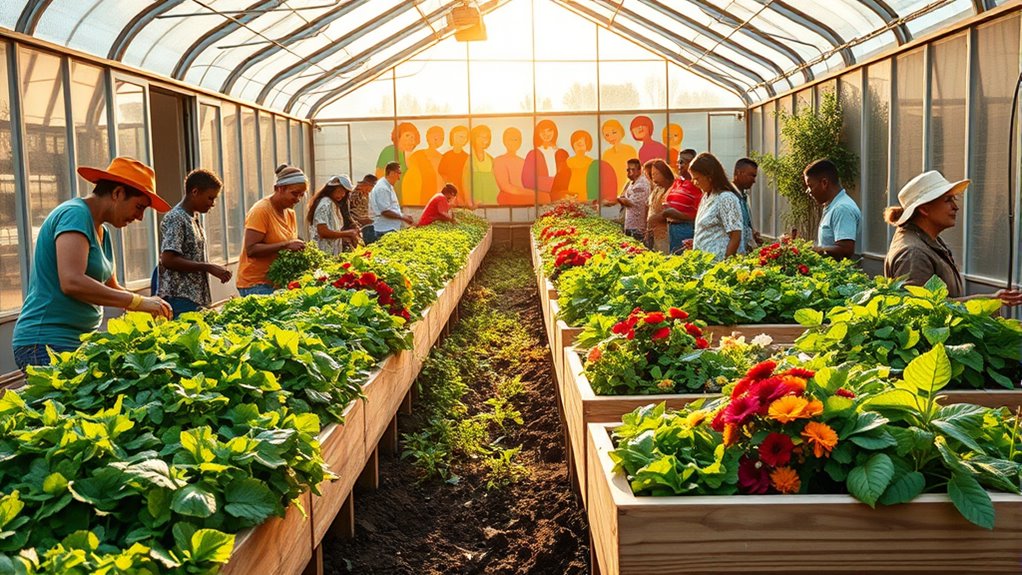
As urban populations grow and the demand for local food production rises, community greenhouse initiatives are rapidly expanding across the globe. You’ll notice that urban areas are increasingly adopting these greenhouses, driven by technological advancements like IoT systems and LED lighting, which enhance efficiency. These structures also offer climate resilience, allowing for year-round crop production. The greenhouse market size is expected to reach USD 32.6 billion by 2024, indicating the increasing importance of these initiatives. Governments support this movement through subsidies, ensuring food security and promoting sustainable practices. Additionally, community greenhouses often incorporate environmental principles that align with sustainable practices, further enhancing their positive impact on local ecosystems. Implementing these greenhouses can also help restore biodiversity hotspots, contributing to healthier urban environments. Engaging local residents fosters community involvement and offers educational programs on sustainable farming, which can lead to better understanding of investment opportunities in local agriculture. As you explore these initiatives, you’ll see how they’re shaping urban landscapes while addressing food needs, mitigating climate change, and optimizing resource use for a healthier environment.
Frequently Asked Questions
How Can I Start a Community Greenhouse in My Area?
Starting a community greenhouse in your area involves a few key steps. First, gather a group of interested locals and brainstorm ideas.
Next, research funding opportunities like grants or partnerships with local organizations. Develop a detailed plan and budget to outline your vision.
Engage the community for input and support, and consider hosting workshops to build enthusiasm.
Finally, get hands-on by involving volunteers in the design and construction processes to foster ownership.
What Plants Grow Best in a Community Greenhouse?
Did you know that nearly 40% of the world’s vegetables are grown in greenhouses?
If you’re looking to maximize your greenhouse, focus on warm season vegetables like tomatoes and cucumbers, which love the heat.
You might also try cool season crops like kale and spinach for year-round growth.
Don’t forget about herbs like basil and mint; they thrive in those controlled conditions, adding flavor to your meals while beautifying your space!
Are There Membership Fees for Community Greenhouse Participation?
Yes, there are often membership fees for participation in community initiatives.
These fees typically cover maintenance and operational costs, ensuring the space runs smoothly.
Depending on the organization, you might find various membership tiers with different responsibilities.
For instance, some memberships may require you to participate in workdays, while others might focus solely on financial support.
It’s important to check specific requirements and costs for the community you’re interested in joining.
How Can I Volunteer at a Community Greenhouse?
Volunteering at a community greenhouse is like planting seeds of change; it nurtures both the environment and your personal growth.
To get involved, check local listings for volunteer opportunities, or visit their websites to sign up. You’ll likely need to fill out an application or background check.
Once you’re in, you can participate in gardening tasks, conservation projects, and join community events, all while gaining valuable skills and connections.
What Tools Are Necessary for Maintaining a Community Greenhouse?
To maintain a greenhouse effectively, you’ll need essential tools like hand trowels for planting, hand forks for aerating the soil, and pruning shears for shaping plants.
Don’t forget gloves to protect your hands! Long-handled tools like shovels and rakes are vital for digging and leveling soil.
For watering, a reliable watering can or hose is fundamental.
Monitoring tools like thermometers and pH testers help guarantee ideal growing conditions for your plants.
Conclusion
In exploring community greenhouses, you might wonder if they truly enhance local food systems or if they merely serve as a gathering place. The truth is, they do both! These spaces foster sustainability, education, and health while boosting local economies. As you engage with your community greenhouse, you’ll see firsthand how it cultivates not just plants, but connections and awareness. So, get involved—your participation could help grow a greener, healthier future for everyone!
